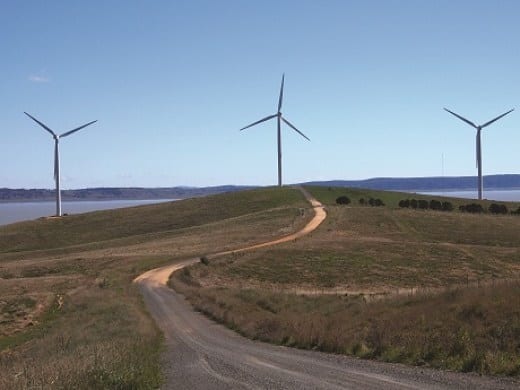The changing global climate should have little impact on the continued success of wind energy generation in Australia, a new study has found – and will in fact boost it in some parts of the country, helping to drive a possible further 30 per cent reduction in costs.
The research, published this month in Environmental Research Letters, weighs up changing winds conditions caused by climate change, advances in technology and investment risk factors to forecast the economics of generating energy from wind farms in Australia in the near future (2020-2039) and the far future (2060-2079).
The study found that the states south of 20° latitude look set to “come out ahead,” particularly Tasmania and the southern half of Western Australia, which the study found would be the biggest winners in terms of power generation and profitability.
In general, these parts of Australia were expected to experience small reductions in wind speed as a result of climate change, but profitability was expected to increase.
“Wind energy production appears resilient to the projected small decreases in wind energy potential, and once technological innovations are taken into account wind energy remains a viable source of energy at least to the end of this century,” the report said.
Even better, “once improvements in technology were factored into the equation, we calculated that the cost of generating power across Australia is likely to decrease by 30 per cent, meaning existing and future wind farms are likely to be more profitable than today,” said author Dr Merlinde Kay from the University of NSW’s School of Photovoltaic and Renewable Energy Engineering.
But in Queensland, and the northern half of Western Australia, wind generation was expected to become less competitive with other states, due to a slight drop in wind speeds and the increased threat of cyclones in those regions.
“North of the 20° latitude the risks increase as wind turbines are subject to cyclonic conditions and investment becomes subject to a potentially increased infrastructure replacement issue,” said Dr Kay.
“However, that doesn’t mean renewable energy has no place in our far north.
“As long as the Sunshine State can maintain a climate that is – as they like to say – beautiful one day and perfect the next, it is likely solar energy will play a key role in renewable power generation in Central Queensland and our far north.”
That may or may not be reassuring for the builders of large wind projects in Queensland, such as Windlab’s Kennedy energy park, although that will be paired with solar, or AGL Energy’s Cooper’s Gap wind farm. Queensland hitherto has only one small (12MW) installation at Windy Hill.
The key takeaway of the research, according to Professor Jason Evans – lead author from the University of NSW’s hub of the Centre of Excellence for Climate Extremes – was Australia’s un-tapped wind energy potential.
“Importantly, the research revealed prime locations in Tasmania and Western Australia for wind farms near existing transmission networks that have yet to be exploited,” Prof Evans said.
“And our research shows these regions will only get better with time as wind speeds in those locations are expected to increase.”










